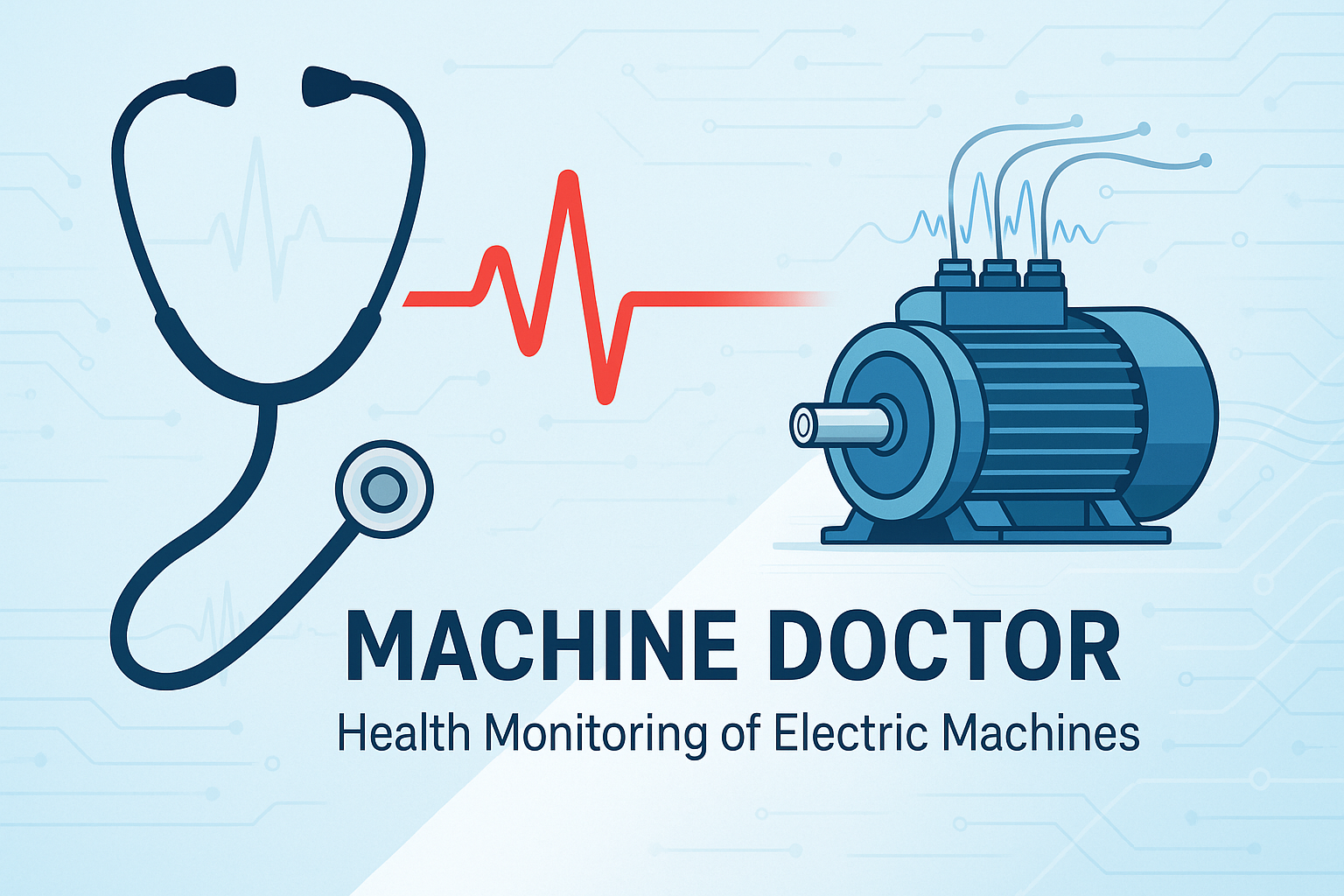When a toddler cries, a parent instinctively tries to figure out what’s wrong: perhaps the child is hungry, in pain, or simply uncomfortable. A doctor, likewise, looks for subtle symptoms in a patient, aiming to catch a problem before it worsens. Electric machines, in their own way, behave similarly. They exhibit subtle “symptoms” before a breakdown occurs, giving engineers a critical opportunity to diagnose and treat these issues before they become severe.
Condition monitoring, or health monitoring of electric machines, acts as a digital doctor for these industrial workhorses. By continuously tracking their vital signs: electrical, mechanical, and thermal parameters, condition monitoring allows early detection of faults, ensuring machines remain reliable and efficient over their operating life.
Why Health Monitoring is Critical ?
Electric machines, ranging from motors and generators to transformers, are at the heart of modern industry. They drive pumps, compressors, conveyor belts, and entire production lines. A single failure can lead to unplanned downtime, lost production, costly emergency repairs, safety hazards, and even reputational damage.
Traditionally, industries relied on two main maintenance philosophies:
Preventive maintenance: Servicing equipment at scheduled intervals, regardless of whether a problem exists.
Corrective maintenance: Fixing equipment after it breaks down.
Both have significant limitations. Preventive maintenance may replace still-healthy components prematurely, wasting resources. Corrective maintenance, meanwhile, is reactive: responding after the failure has already caused damage.
Condition monitoring changes the game by providing a smarter, predictive approach. It detects subtle changes in machine behavior, spotting faults in their initial stages and giving maintenance teams the time to intervene. In effect, it moves maintenance from a reactive or scheduled activity to a data-driven, condition-based strategy.
How Does Condition Monitoring Work?
Just like a doctor performing a health checkup, condition monitoring relies on sensing, recording, and analyzing a machine’s “vital signs.” These include:
- Electrical parameters: current, voltage, harmonics, insulation resistance
- Mechanical parameters: vibration, speed, torque, alignment
- Thermal parameters: winding temperature, bearing temperature
- Acoustic parameters: noise levels, frequency content
Data from these sensors is processed by diagnostic algorithms or even machine learning models to detect trends, patterns, or sudden anomalies. Any deviation from the machine’s normal “baseline” behavior can be flagged for further investigation.
For example, an increasing vibration level at a specific frequency might indicate a developing bearing fault. A slow rise in winding temperature could hint at insulation degradation. Or, changes in current waveform harmonics might reveal broken rotor bars in an induction motor.
In short, condition monitoring converts symptoms into actionable maintenance decisions.
Examples of Condition Monitoring in Practice
Let’s look at how health monitoring is applied to common industrial electric machines.
1. Electric Motors
Electric motors are the most widely used electromechanical devices in industry. Their failure can disrupt entire production processes. Condition monitoring techniques for motors include:
- Vibration analysis: detects bearing faults, shaft misalignments, unbalances
- Motor current signature analysis (MCSA): identifies rotor bar breaks, air-gap eccentricities, or stator faults
- Temperature monitoring: protects windings and bearings from thermal damage
- Insulation resistance testing: tracks gradual insulation degradation
- Partial discharge monitoring: especially in high-voltage motors, helps identify insulation weaknesses
2. Transformers
Transformers are critical assets in power transmission and distribution, yet they are subject to insulation aging, moisture, overheating, and internal arcing. Condition monitoring of transformers uses techniques like:
- Dissolved gas analysis (DGA): detects gases formed by insulation faults, arcing, or overheating
- Oil quality analysis: measures moisture, acidity, and dielectric strength
- Partial discharge monitoring: identifies insulation cracks or voids
- Temperature monitoring: via temperature sensors or infrared cameras
- Bushing monitoring: checks capacitance and tan delta (power factor) to spot incipient failures
3. Generators
Generators, whether in power plants or renewable energy systems, require condition monitoring for uninterrupted operation. Techniques include:
- Rotor flux monitoring: detects shorted turns in rotor windings
- Stator insulation tests: for partial discharge activity
- Temperature and vibration sensors: to monitor bearings and windings
- Air gap monitoring: to detect rotor eccentricities
4. Other Assets: Pumps, Compressors, Gearboxes
While these are not strictly electric machines, they are often driven by electric motors, and their health directly affects the overall system. Condition monitoring uses:
- Vibration analysis for bearing wear and misalignment
- Oil analysis for contamination and wear particles
- Acoustic emission for early-stage faults
Benefits of Machine Health Monitoring
When deployed correctly, condition monitoring brings measurable benefits to industries:
Reduced downtime: Failures are predicted, not reacted to.
Lower maintenance costs: Maintenance is performed based on condition, not arbitrary schedules.
Improved safety: Avoids sudden breakdowns that might endanger workers.
Longer machine life: Faults are caught before they propagate into severe damage.
Sustainable operation: Minimizes waste by replacing only what is necessary.
Higher production reliability: Healthy machines mean fewer interruptions to output.
In today’s competitive industrial world, where equipment is expected to run continuously, these benefits cannot be overstated.
The Future: Smarter Machine Doctors
The world is now entering a new era of industrial digitalization, thanks to the Industrial Internet of Things (IIoT) and artificial intelligence. Modern condition monitoring systems go far beyond simple threshold alarms. They connect wirelessly, upload data to the cloud, and use AI-based predictive models to forecast remaining useful life (RUL) of critical components.
Technologies like digital twins (virtual models of physical machines), allow engineers to simulate fault conditions and optimize maintenance plans even before problems occur. Combined with edge computing, these solutions provide near-real-time analytics directly at the machine site, making diagnosis faster and more precise.
For instance, a digital twin of a hydro-generator might simulate how a crack propagates in the rotor, helping plan maintenance weeks in advance. Or a cloud-connected platform could analyze vibration data from hundreds of motors across multiple sites, prioritizing interventions automatically.
Conclusion: The New Industrial Doctor is Here
Much like a doctor who listens to a patient’s heartbeat or a parent who notices a child’s subtle cry for help, engineers can now listen to their machines in ways never possible before. Condition monitoring, the “machine doctor,” is transforming industrial maintenance by replacing guesswork with data-driven certainty.
By harnessing sensors, data analytics, and predictive algorithms, industries can ensure their electric machines stay healthy, reliable, and safe, minimizing costly breakdowns and maximizing performance. As we look to the future, ever smarter and more connected monitoring solutions will continue to advance, empowering industries to build a safer, more efficient, and more sustainable world.
Because when machines speak, it is our job to listen.

CTO @ Fifty Hertz Tech
Researcher in Electric Machines, Condition Monitoring, Energy Efficiency, Electric Vehicles, Fault Diagnostics

